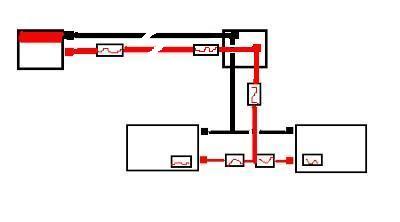The idea of fusing the main power wire is to protect the car from fire if the wire should be damaged and short out. Fusing for any power wire should be to the capacity of the wire, not to the capacity of the appliances connected downstream. With a 250 amp alt, it's your choice whether to use 2 ga. or 1/0 for your sound system. If you use 2 ga., fuse the main wire at the source (the batt. under the hood) with a 225 amp fuse or breaker. See Power and Ground Cable Specs.
You should use 1/0 for the Big 3 upgrades due to the fact that 2 ga. is a lower capacity than the alt outputs. But wiring from the batt. to the sound system could be 2 ga. and give it plenty of current-carrying capacity. That's up to you which to use for the run from engine to trunk, but if you use a 1/0 for this you should still follow the guidelines of fusing wires, with this exception: if the power supply is no more than 250 amps, you can fuse the 1/0 wire to that rating instead of going up to 350 amps.
Let's look at some other things. A cap will only discharge to an amplifier if the amplifier demands it. You don't need to separate the 2nd batt/cap from the 4 channel amp...if that amp doesn't demand the boost it will not be a factor. This is to say, you should simplify the install by wiring as a "2 battery" system, with the batt/cap as your second battery connected in parallel with the main battery. All system components are connected to the second battery, which is in their vicinity. Since you are wiring its ground directly to the main battery, the ground on the 2nd batt will be your grounding point for all components...the chassis will not be the ground return. (Actually, your pic shows all parallel wiring, which is an instant connection at all points. Even though you show a separation of components and have it arranged as such, they are all instantly connected. The four channel amp is thus connected to the batt/cap in your depiction just as much as the mono amp is.) And you need more fuses in the scheme because you have a second battery involved.
Fusing: If it weren't for the sake of safety there would be no use for fuses whatsoever. With safety in mind, when a power wire is downsized at any point, the lesser ga. wire needs its own protective fuse. The fuse is placed at the source end of the wire. The closest place on that wire to the source (battery) is the junction where it branched off of the main wire. So when you have a large main power wire split to feed multiple amps, the wires to those amps need to be fused at the point of distribution.
As you follow the path further downstream, the amplifier fuses the incoming current at the source side as well. The amp's fuse protects the amp, not the wire that feeds it. So if you are using 4 ga. wires to the individual amps, each wire should be fused with a 150 amp fuse. (Fuse ratings are typically lowered closer to the capacity of the appliance than to the capacity of the wire in these situations, but they remain higher than the appliance values but not higher than the wire capacity.)
Here's a schematic for what I described. The fuses on the smaller wires feeding the amps are a diagram of a fused distro block. The power and ground wires exiting the second battery are the same ga. as the main wires connecting the batteries (because they are a continuation from the power source), and the fuses at the 2nd batt are rated per the wire gauge, as is the fuse at the main battery. Regardless of how the wires are run, the second battery remains as a high current storage device, and so all outgoing wire runs need to be fused. That's why the fuses shown on both wires into and out of it.

Your setup requires three main power wire fuses and one fused distribution block.
Build the box so that it performs well in the worst case scenario and, in return, it will reward you at all times.
 Printable version
Printable version












 The numbers should all be in there, though if there are any questions, let me know... the lines from the battery to the first distribution block are 1/0ga and all wires past that are 4ga. From the battery to the distribution block is about 15ft, after that from the distribution block to the amps is less than 2ft.
Also the cap is a hybrid battery/capacitor setup that I'm planning to just run the Sub-amp off of. The instructions with it said to ground to the battery. I figured since I'm already grounding one amp to the battery, might as well ground both to the battery? Or is my logic flawed there?
Thanks for any insights!
C2K
The numbers should all be in there, though if there are any questions, let me know... the lines from the battery to the first distribution block are 1/0ga and all wires past that are 4ga. From the battery to the distribution block is about 15ft, after that from the distribution block to the amps is less than 2ft.
Also the cap is a hybrid battery/capacitor setup that I'm planning to just run the Sub-amp off of. The instructions with it said to ground to the battery. I figured since I'm already grounding one amp to the battery, might as well ground both to the battery? Or is my logic flawed there?
Thanks for any insights!
C2K






